Varietal characteristics of the Skala apple tree
Apple-tree Skala is a popular variety. It was bred in the late 90s, has a high level of frost resistance and a special Vf gene, which helped the species gain high immunity.
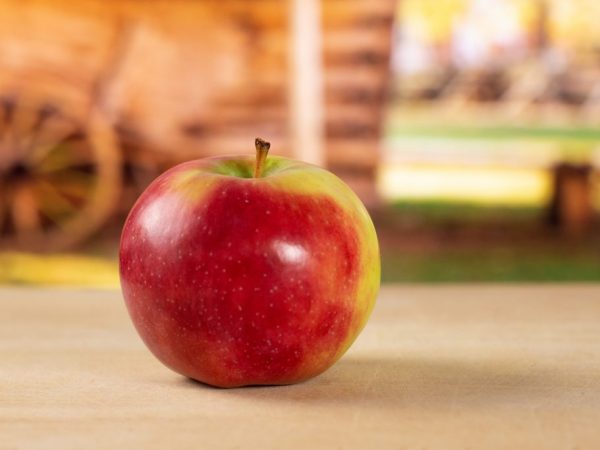
Characteristics of the variety
When choosing varieties for growing, gardeners pay attention to their characteristics. This apple tree has won the favor of many.
Description of the tree and fruit
The apple tree is medium-sized, its maximum height reaches 7 m. In rare cases, the tree can grow up to 8 m. The branches are thick, not very close to the trunk. They have a uniform, gray tint.
The bark is dense and thick, with cracks. It has a brown color interspersed with gray.
Leaves are light green, rounded at the bottom and elongated upward, glossy. The flowers are light pink with a loose arrangement of petals.
The fruits are large, round and symmetrical. By weight they reach 250-300 g.
The apple peel is free of wax, pleasant to the touch and glossy. Severe dryness is noted. The color is yellow-green with a red blush. The pulp is firm, creamy and grainy.
Taste
Apples have a special taste. The fruits are sweet with a bright sourness. Some consumers have a more sour taste and use apples more readily in cooking than fresh apples.
Yield
One of the reasons for the popularity of the variety is its high yield. From 1 hectare, you can harvest an average of 210 centners of fruit With proper care, this figure can increase to 250 centners. The tree is stable, if you have achieved a yield of 240 centners per hectare, next year this figure will be kept at approximately the same level.
According to the description of the Skala apple tree, it begins to bear fruit 6-9 years after planting. Harvesting occurs in autumn (September), while the storage period lasts until December.
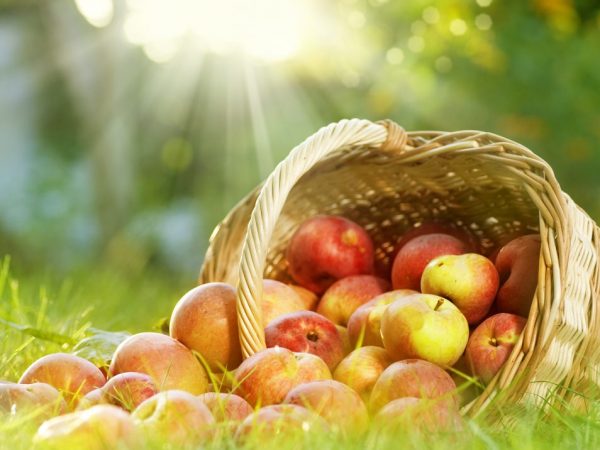
Selecting a pollinator variety
The apple tree of this variety is self-fertile. This makes certain adjustments to the care of the tree and the choice of the neighborhood. Plant a crop that blooms in early May near this tree. Make a start only from this rule. The rest of the aspects are not important.
Take care of the presence of bees and bumblebees in your area, they will speed up the pollination process.
Winter hardiness
An important advantage of the variety is frost resistance. In laboratory conditions, the tree was kept at -40 ° C. The apple tree did not receive negative consequences. The main part of her was not affected, and the damage received by the kidneys was minimal.
Disease resistance
The Skala variety is considered disease resistant, which offers another great advantage. The reason for this is a special gene that was introduced into this species. It makes it resistant to scab and many other fungal diseases.
The apple tree is highly susceptible to the formation of fruit rot and bitter pitting.
The occurrence of fruit rot is associated with the granular structure of the pulp, in which decomposition processes are much easier. The disease begins with a small brown spot that subsequently spreads to the entire apple.
The second common disease is subcutaneous spotting, which is better known as bitter pitting. It is a rash on the apple in the form of dimples, dark spots and wounds. These lesions are darker in color than healthy parts of the fetus. The causes of the disease depend on its type.
There is a speck acquired on a tree, the causes of which are:
- not enough sun;
- high level of humidity during flowering and ripening of fruits;
- overripening of fruits;
- a large amount of nitrogen in the soil;
- lack of calcium.
The second type of disease in apples appears during storage, if poor conditions are created for this.
Saplings cost
The price of seedlings directly depends on their quality and delivery method.
A good seedling with a developed root system, without damage and well-packed (in a plastic container that protects against any possible damage) will cost the gardener 600-620 rubles.
If you want to save money, go to the question of choosing seedlings more thoroughly. You can come to the nursery and independently inspect all the proposed trees. Here you will spend from 150 to 300 rubles for a seedling.
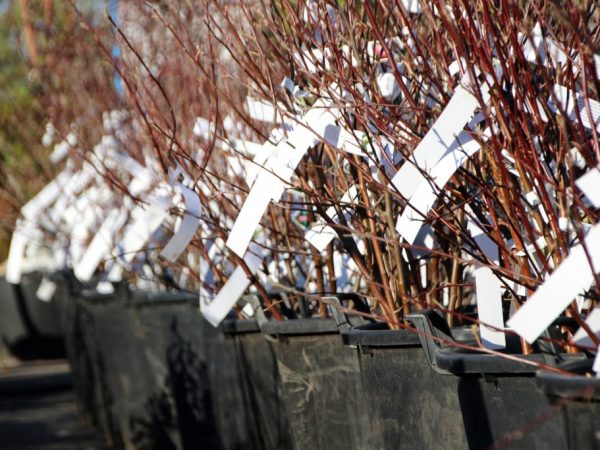
Landing features
The quality and quantity of future fruits directly depends on planting and further care. If you follow the rules, after 6 years you can get a large and tasty harvest, while neglecting the recommendations can leave you without fruit.
Landing dates
You can plant a tree in autumn, spring and summer. The timing directly depends on the apple tree. If you have chosen the option with an open root system, plant it in spring or early summer.
A young tree will take root better if it is planted 2-3 weeks before the onset of the first frost.
Technology
After choosing the right seedling (with good roots, relatively young age and taken from an area with similar weather conditions), you should think about a place for future planting of the Skala apple tree.
Pay attention to the illumination of the area. An important aspect is choosing a part of the garden without strong winds. Drafts can severely damage the tree. The presence of drainage in the soil and its porosity will allow the tree to "breathe". The land should be clayey and with a fairly deep groundwater table.
The tree is whimsical to the planting pit. It should be 70 x 55-60 cm in size. The trees should be planted at a 3-meter distance. It is worth adding rotted horse manure - 15-20 kg, potassium (100 g), wood ash and superphosphate (240 g of each fertilizer) to the top layer of the earth.
Fill the hole with the mixture you made two-thirds full. Then fill the hole with soil without any fertilizer. Plant a tree, remembering to tie it up.
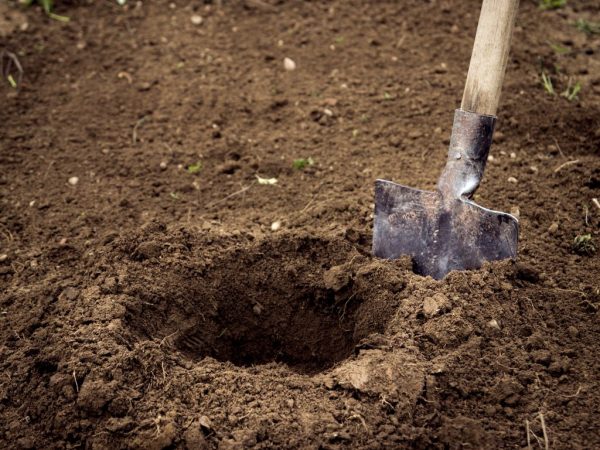
Care
During pruning, you shape the crown and set the correct growth vector for it. In the first years, cut it according to the following scheme: remove the upper branches at an acute angle, and do not touch the lower ones.
Do not let the Skala apple tree waste energy on fruits. Pluck most of the flowers during the flowering period. So the tree will conserve energy for development.
Treat the tree from pests for the first year. For these purposes, insecticides are suitable. The procedure should be carried out during the appearance of buds on the tree and flowering.
In the future, the apple tree does not need special care: it is only necessary to prune on time, tie the tree to protect it from rodents, spud and mulch. Fallen leaves, grass, sawdust, etc. are suitable for the latter process. Some gardeners carry out peat feeding annually.
Features of ripening and fruiting
As noted earlier, high-quality fruiting occurs 6-9 years after planting.The crop yields a stable crop, without sharp changes in the number of apples per hectare.
The tree has a lifespan of about 55-60 years.
Flowering begins in May - early June. Fruits appear in autumn, the exact time depends on the region. In warmer places, the apple tree produces fruit in September, in cold places - in early October.
Harvesting and storage
Harvesting is carried out after ripening, without letting the fruits overripe. Collect them carefully, without damaging the apples.
Store them in a cool, dark place. It is recommended to pack each fruit separately in sheets of paper or newspaper. The shelf life of apples is up to 3 months.
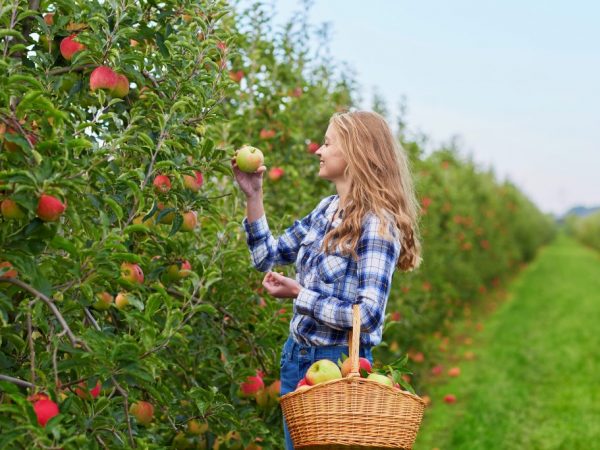
Prevention of diseases and parasites
Despite good immunity, the Skala apple variety needs preventive measures.
To prevent disease, inspect the fruit as it ripens and remove spoiled or damaged apples. The fungus from them can move to healthy trees. Harvest on time. Don't let it overripe. Do not store apples in the light or in highly humid places.
In the first year after planting, treat the tree with fungicides or insecticides. This will help fight insects.
Testimonials
The general assessment of the gardeners is positive. They note the good resistance of the apple tree to cold weather, high productivity and a high rate of development of the seedling.
Some say the fruit tastes more sour than sweet. This variety has proven itself as an ingredient in cooking, preserves, jams, etc.

